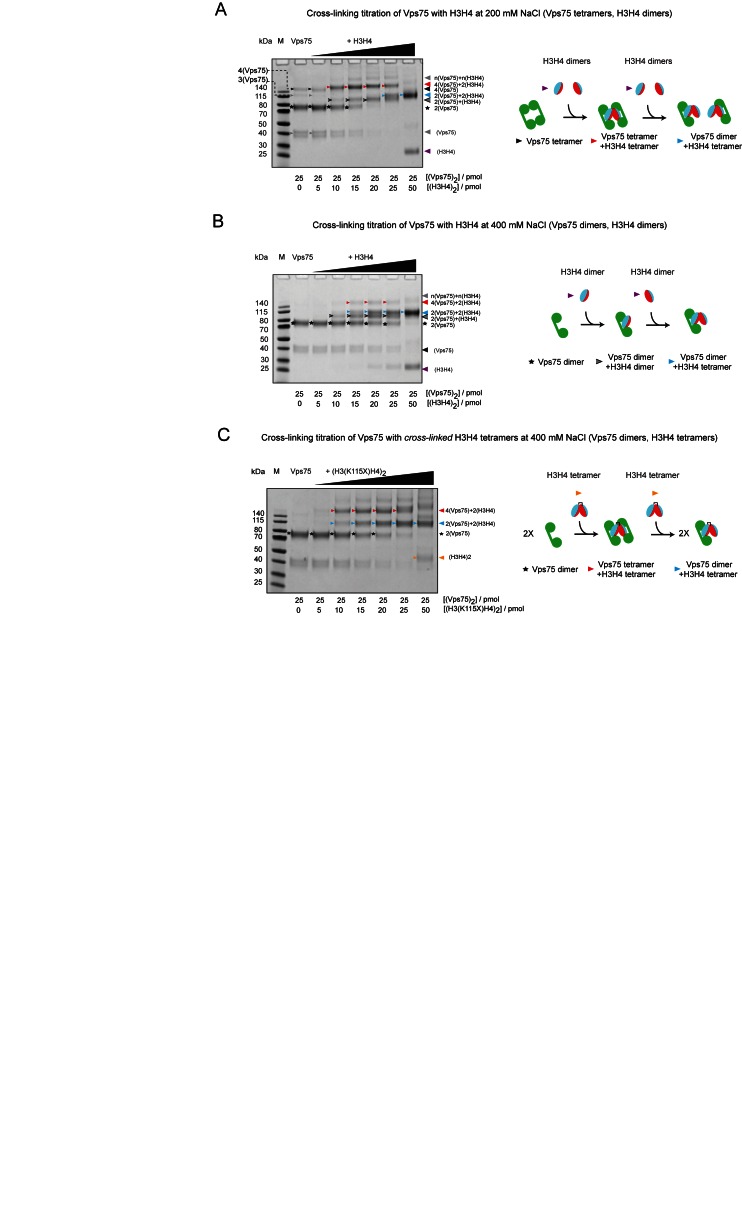Figure 4.
The Vps75 tetramer can cooperatively recognize a H3–H4 tetramer at low salt concentrations. SDS-PAGE analysis of cross-linking reactions of wild-type Vps75 incubated with increasing concentrations of H3–H4 at (A) 200 mM NaCl and (B) 400 mM NaCl. (C) SDS-PAGE analysis of cross-linking reactions of wild type Vps75 incubated with increasing concentrations of pre-cross-linked, by BMOE linkage of H3 K115C (denoted K115X), H3–H4 tetramers at 400 mM NaCl. All cross-linking reactions were performed for 1 h with 2 mM BS2G and run on 4–12% Bis–Tris SDS-PAGE gels (Invitrogen). M = PageRuler Prestained Protein Ladder (Thermo Scientific). Molar amounts of Vps75 and H3–H4 present in each titration point are shown below each lane. Bands are marked with arrows and stars as referred to in the schematic next to each titration. Higher order oligomers are observed above the Vps75 tetramer bound to a H3–H4 tetramer in titrations (A) and (C) which may indicate the presence of high order oligomers. Vps75 H3–H4 complexes observed in cross-linking titrations were interpreted as follows: (A) Under conditions that favour the Vps75 tetramer (200 mM NaCl), a cross-linking species of a Vps75 tetramer bound to a H3–H4 tetramer (red arrow) is preferred at low histone stoichiometries, at high histone stoichiometry each dimer of Vps75 is bound to a H3–H4 tetramer (blue arrow); (B) under conditions that favour a Vps75 dimer (400 mM NaCl), initially the dimer of Vps75 binds a dimer of H3–H4 (gray arrow with black outline) in a manner that does not obstruct H3–H4 tetramerization—which then occurs on Vps75 as the H3–H4 stoichiometry increases (blue arrow); (C) under conditions that favour a Vps75 dimer (400 mM NaCl) and when H3–H4 is trapped in a tetrameric conformation, initially the two dimers of Vps75 bind the preformed H3–H4 tetramer (red arrow), at high histone stoichiometry the histone binding capacity of Vps75 is saturated and each dimer binds a pre-formed H3–H4 tetramer (blue arrow).

